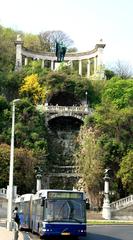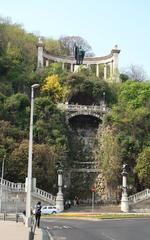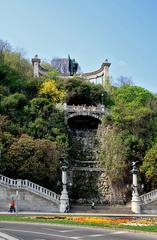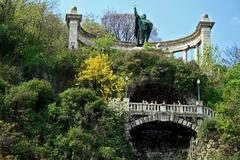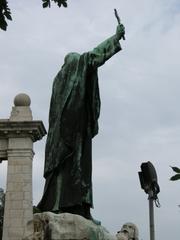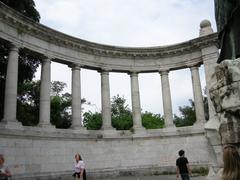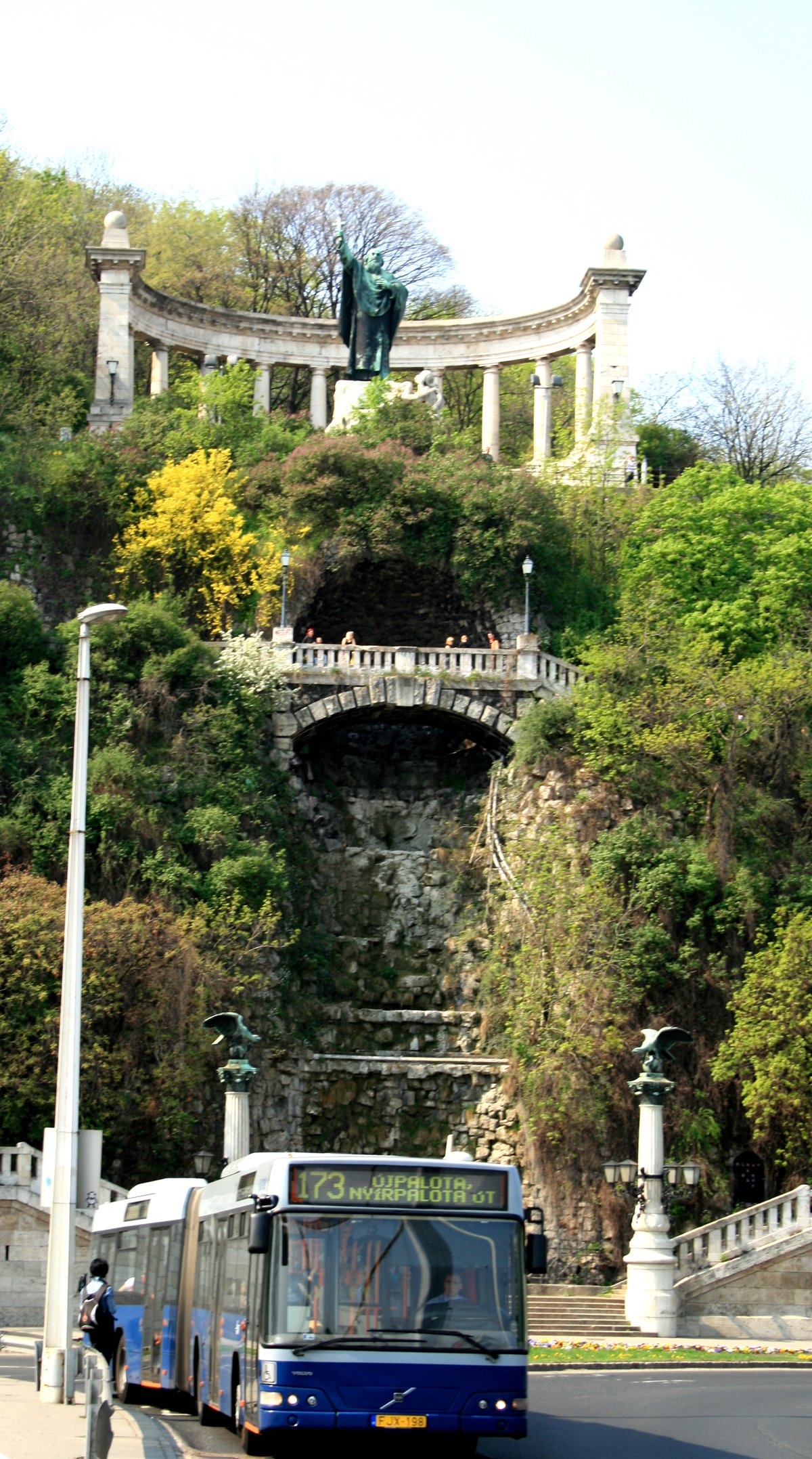
Visiting the Gerard Sagredo (Szent Gellért) Monument, Budapest: Complete Guide to Historical Significance, Hours, Tickets & Visitor Tips
Date: 15/06/2025
Introduction
The Gerard Sagredo Monument, also known as the Szent Gellért Monument, stands as a powerful symbol of Hungary’s Christian heritage and national identity. Perched on the northeastern slope of Budapest’s Gellért Hill, this monument commemorates Saint Gerard Sagredo—a Venetian-born Benedictine bishop whose martyrdom in the 11th century marked a turning point in Hungary’s religious history. With its commanding bronze statue, classical colonnade, and panoramic views over the Danube and cityscape, the monument invites visitors to connect with the city’s past while enjoying one of Budapest’s most spectacular vantage points (budapest.city; hungarytoday.hu).
This guide provides a comprehensive overview of the monument’s history, architectural features, practical visitor information (including hours, tickets, and accessibility), travel tips, and recommended nearby attractions. Whether you are a history enthusiast, photographer, spiritual pilgrim, or casual tourist, the Gerard Sagredo Monument offers a rewarding experience at the heart of Budapest’s cultural landscape.
Table of Contents
- Saint Gerard Sagredo: Life and Legacy
- Monument Design, Architecture, and Symbolism
- Visitor Information: Hours, Tickets, Accessibility
- Travel Tips and Practical Advice
- Nearby Attractions and Suggested Itineraries
- Restoration and Preservation
- Frequently Asked Questions (FAQ)
- Conclusion and Final Tips
- References
Saint Gerard Sagredo: Life and Legacy
Saint Gerard Sagredo (Hungarian: Szent Gellért) arrived in Hungary in 1015, originally en route to the Holy Land. Persuaded by King Stephen I, he became an influential missionary, the first bishop of Csanád, and tutor to Prince Imre. Gerard’s fervent efforts to convert the pagan Magyar tribes made him a revered religious leader but also a target. In 1046, during the Vata pagan uprising, Gerard was martyred—legend holds he was placed in a spiked barrel and rolled from Gellért Hill into the Danube (justbudapest.com; wikipedia.org).
Canonized in 1083, Gerard’s legacy endures as the patron saint of Hungary. The monument, Gellért Hill, the Gellért Baths, and numerous city landmarks bear his name (budapest.city).
Monument Design, Architecture, and Symbolism
Architectural Composition
- Colonnade: The monument features a semicircular colonnade of twelve Corinthian columns (approx. 6 meters tall), crafted from white limestone. The colonnade’s classical design evokes ancient Roman and Greek architecture, symbolizing Christianity’s enduring legacy in Hungary (Hungary Today).
- Pedestal and Reliefs: At its center stands a tall limestone pedestal, adorned with narrative bas-reliefs and inscriptions in Latin and Hungarian that recount Gerard’s martyrdom and legacy (Hungarian Tourism Agency).
Statue
- Artist: Gyula Jankovits (sculptor) and Gyula Hegedűs (architect) designed the monument, unveiled in 1904.
- Depiction: The 3.5-meter bronze statue portrays Saint Gerard in episcopal robes, right arm raised with a cross, left hand extended to bless the city—a gesture of faith and protection (Visit Budapest).
- Materials: Bronze for the statue, white limestone for the colonnade and base; the bronze has developed a dignified patina over time.
Symbolic Features
- Waterfall: An artificial waterfall flows beneath the colonnade, symbolizing both the Danube (where Gerard perished) and the cleansing power of faith (Budapest by Locals).
- Setting: The monument’s elevated position offers sweeping city views, making it one of Budapest’s prime scenic and photographic locations.
Visitor Information: Hours, Tickets, Accessibility
Hours
- Open 24 hours a day, year-round. For safety and the best experience, visits are recommended during daylight (8:00 AM–sunset).
Tickets and Entry
- Admission is free; no tickets are required.
Accessibility
- Paths: Access is via paved but sometimes steep and uneven paths; suitable for most visitors, but challenging for those with mobility impairments.
- Rest Areas: Benches are available along the ascent.
- Restrooms: Facilities are found at the base of Gellért Hill, near Szent Gellért tér and the Gellért Baths.
Getting There
- Public Transport: Metro Line M4 to Szent Gellért tér, then a 15–25 minute walk uphill. Trams 47/49 and several buses also serve the area (BKK Budapest).
- On Foot: Walkable from central Budapest; allow extra time for the climb.
- By Car/Taxi: Private cars are not allowed on monument paths, but taxis can drop you at the base.
Travel Tips and Practical Advice
- Best Times: Spring (April–June) and autumn (September–October) offer mild weather; early morning and late afternoon provide the best lighting and fewer crowds.
- Footwear: Wear comfortable shoes with good grip; paths can be slippery when wet.
- Safety: The park is safe, with regular patrols; remain aware of your belongings, especially during busy periods (Budapest Police).
- Photography: Personal photography is encouraged. Drone use requires permits (Hungarian Civil Aviation Authority).
- Signage: Information is provided in Hungarian and English.
Nearby Attractions and Suggested Itineraries
Gellért Hill and Surroundings
- Citadella and Liberty Statue: Short walk uphill for panoramic views and WWII history.
- Gellért Baths: Art Nouveau thermal baths at the hill’s base (Gellért Baths).
- Cave Church: Unique church carved into the rock face, open to visitors.
- Jubilee Park: A rose garden celebrating Budapest’s 150th anniversary.
Buda Castle District
- Buda Castle, Fisherman’s Bastion, Matthias Church: Accessible by foot or bus; rich in art, history, and architecture.
Danube Embankment and Pest
- Elisabeth Bridge and Promenade: Scenic city walks and access to Pest’s landmarks, including St. Stephen’s Basilica and Andrássy Avenue.
Suggested Itineraries
- Half-Day: Gerard Sagredo Monument → Liberty Statue → Citadella → Gellért Baths or Danube promenade.
- Full-Day: Include Buda Castle District, Pest’s city center, and a Danube river cruise.
Restoration and Preservation
- Restoration: The monument has undergone several restorations—most notably post-WWII and in recent decades—to repair war damage and weathering. Conservation includes cleaning limestone, stabilizing bronze, and restoring inscriptions (welovebudapest.com).
- Lighting: Modern illumination highlights the monument at night.
- Access Improvements: Pathways have been upgraded, but the climb remains moderately challenging.
Frequently Asked Questions (FAQ)
Q: What are the visiting hours for the Gerard Sagredo Monument?
A: Open 24 hours, year-round; daylight visits are best.
Q: Is there an entrance fee?
A: No, visiting is free.
Q: How do I get there?
A: Use public transit to Szent Gellért tér, then walk uphill.
Q: Are guided tours available?
A: Yes, many city tours and river cruises feature the monument (getyourguide.com).
Q: Is the monument accessible for visitors with limited mobility?
A: The climb is moderately steep; access to lower park areas is easier, but direct paths to the statue are not wheelchair-accessible.
Q: Are there restrooms or cafés at the monument?
A: Restrooms and refreshments are available at the base of Gellért Hill near Szent Gellért tér and the Gellért Baths.
Conclusion and Final Tips
The Gerard Sagredo Monument is not only a striking work of art but also a profound testament to Hungary’s spiritual roots and national pride. Its commanding presence, historic setting, and panoramic views make it a must-see for anyone visiting Budapest. Take time to explore nearby sites on Gellért Hill, the Buda Castle District, and Pest. For the best experience, visit during spring or autumn, wear comfortable shoes, and consider a guided tour for deeper context.
Enhance your visit with digital resources like the Audiala mobile app for audio guides and real-time updates. Follow our recommended itineraries and practical tips to make the most of your journey through Budapest’s historical heart.
References
- Saint Gerard Sagredo Monument in Budapest: History, Visiting Hours, Tickets & Travel Tips (budapest.city)
- Gerard Sagredo Monument Budapest: Visiting Hours, Tickets & Historical Guide (hungarytoday.hu)
- Visiting the Gerard Sagredo Monument in Budapest: Hours, Tickets, and Tips (budapestinfo.hu)
- Exploring the Gerard Sagredo Monument and Nearby Historical Sites (getyourguide.com)
- Gerard Sagredo Monument Restoration and Preservation (welovebudapest.com)
- Budapest Police Safety Information (police.hu)
- Hungarian Civil Aviation Authority Drone Regulations (nkh.gov.hu)
